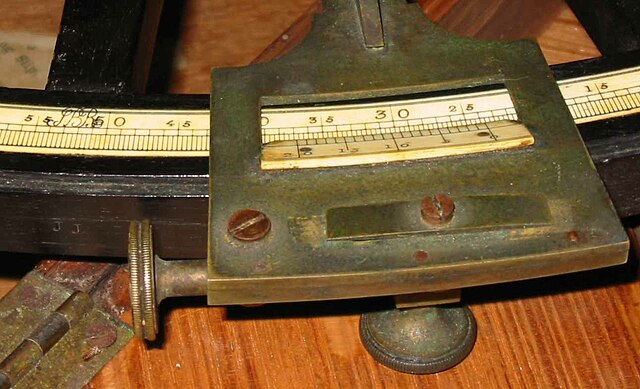The octant, also called a reflecting quadrant, is a reflecting instrument used in navigation.
Octant. This instrument, labelled Crichton - London, Sold by J Berry, Aberdeen, appears to have an ebony frame with ivory scale, vernier and signature plate. The index arm and mirror supports are brass. Rather than use a sighting telescope, this instrument has a sighting pinnula.
Octant reverse side. This side is not seen in photographs very often. On the right, the thumbscrew to adjust the horizon mirror can be seen. At the top, one of the feet on which the octant rests in its case is just below the index arm axis. On the left the notepad is clearly visible. This small keystone-shaped piece of ivory, scarcely larger than a thumbnail, was used by the navigator to record his readings.
Details on an octant. This photo shows the graduated scale and the end of the index arm with the vernier. The thumbscrew used to lock the index arm position is seen below the index arm while the thumbscrew used for fine adjustment of the arm is on the left. To the right of the value 50 on the main scale, the SBR logo is engraved. The scale is directly graduated in degrees and thirds of a degree (20'). The vernier can divide the 20' intervals to the nearest minute of arc.
Octant details showing the double-holed sighting pinnula. Also visible is the small cover that can block one or the other of the holes. The horizon mirror is on the opposite side of the instrument. The left side is transparent while the tin amalgam on the mirrored side has completely corroded and no longer reflects light. The back of the index mirror's holder is at the top and the three circular glass shades in square frames are between the two mirrors.
Reflecting instruments are those that use mirrors to enhance their ability to make measurements. In particular, the use of mirrors permits one to observe two objects simultaneously while measuring the angular distance between the objects. While reflecting instruments are used in many professions, they are primarily associated with celestial navigation as the need to solve navigation problems, in particular the problem of the longitude, was the primary motivation in their development.
Representative drawing of Robert Hooke's reflecting instrument. It does not accurately depict the fine details of the instrument but rather the basic functionality. The index with telescope mounted is shown in black, the radius arm with the mirror (grey) attached in blue and the chord in green on white. The lines of sight are represented by the red dashed line.
Borda's reflecting circle, on display at Toulon naval museum
Mendoça's reflecting circle on display at the Musée national de la Marine.







